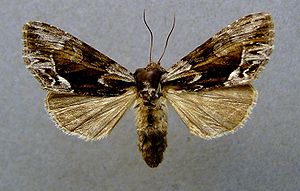Blueberry Crescent Owl
| Blueberry Crescent Owl | ||||||||||||
|---|---|---|---|---|---|---|---|---|---|---|---|---|

Blueberry-haired owl ( Hyppa rectilinea ) |
||||||||||||
| Systematics | ||||||||||||
|
||||||||||||
| Scientific name | ||||||||||||
| Hyppa rectilinea | ||||||||||||
| ( Esper , 1788) |
The hyppa rectilinea ( Hyppa rectilinea ) even blueberry forest Stricheule , Stricheule , blueberry Krauteule is called a butterfly ( moth ) from the family of cutworms (Noctuidae).
features
The wingspan of the moth is 33 to 41 millimeters. The forewings show strong contrasts. While the middle field is mostly dark brown in color, the drawing elements in the root and fringe areas are white-gray in color. The inner transverse line is very jagged. Ring and kidney defects are colored light gray, but often only stand out indistinctly. A large, whitish W in the wavy line is noticeable. Characteristic for the species are a broad, dark root welt and some black lines in the submarginal region . The hind wings are colored gray-brown with little drawing.
Adult caterpillars vary from dark yellow to reddish brown. The back line is narrow, the side back lines are only indistinctly drawn. The side stripes are narrow, whitish-yellow in color with a wavy upper border. On the 8th segment of the abdomen, the lateral line is enlarged to form a broad, yellow spot. Dark diamond-shaped spots are formed on the back.
The slender doll is colored brown. The cremaster is studded with two thorns.
Geographical distribution and habitat
The species occurs in Europe from Scotland in the west across central and northern Europe as well as in southern Europe in fragmented areas, especially in the mountains. In France, the species is essentially limited to the Vosges and the Alpine regions with the exception of isolated occurrences in the Ardennes, the Massif Central and the Pyrenees. The distribution area extends further east through Siberia and Eastern Siberia to the Pacific .
The blueberry owl prefers coniferous forests, boggy heaths and raised bog areas .
Way of life
The blueberry owl forms one generation per year. The moths fly from late May to early August. The moths are nocturnal and appear in artificial light sources and very much like on bait . The eggs are laid individually or in small groups on the leaves of the host plants. The caterpillars are nocturnal and prefer to eat blueberries ( Vaccinium myrtillus ), bogberries ( Vaccinium uliginosum ) and other blueberries ( Vaccinium ), blackberries ( Rubus ) or willow species ( Salix ). They overwinter in a hibernarium on the ground and only pupate in the following spring. The puppet rest takes about three weeks. In breeding, the caterpillar can develop further without overwintering.
Danger
In Germany, the blueberry owl occurs in different numbers and is on the red list of endangered species on the warning list.
swell
Individual evidence
- ↑ Red lists at Science4you
- ↑ a b Fibiger & Hacker (2007: p. 182/3)
- ↑ a b Ahola & Silvonen (2009: p. 99/100)
- ^ Forster & Wohlfahrt (1971: p. 122)
- ↑ GS Zolotarenko and VV Dubatolov: A check-list of Noctuidae (Lepidoptera) of the Russian part of the West Siberian Plain. Far Eastern Entomologist, 94: 1-23, Vladivostok 2000 ISSN 1026-051X PDF
- ↑ a b Steiner (1997: pp. 358–361)
- ↑ Federal Agency for Nature Conservation (Ed.): Red List of Endangered Animals in Germany . Landwirtschaftsverlag, Münster 1998, ISBN 3-89624-110-9 .
literature
- Walter Forster , Theodor A. Wohlfahrt : The butterflies of Central Europe. Volume 4: Owls. (Noctuidae). Franckh'sche Verlagshandlung, Stuttgart 1971, ISBN 3-440-03752-5 .
- Axel Steiner: The butterflies of Baden-Württemberg. Volume 6. Moth IV (Noctuidae 2nd part). Ulmer Verlag Stuttgart 1997, ISBN 3-8001-3482-9 .
- Matti Ahola and Kimmo Silvonen: Larvae of Northern European Noctuidae. Vol. 2. 672 pp., 2008 ISBN 978-952-92-2888-1 .
Web links
- www.lepiforum eV Photos
- www.schmetterlinge-deutschlands.de Endangerment
- www.faunaeur.org Taxonomy (English)